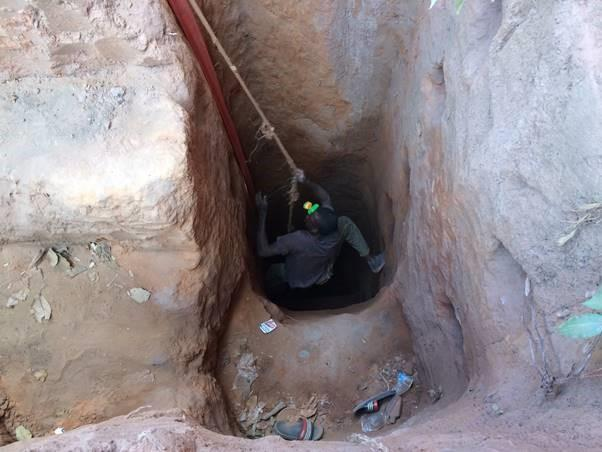Jan 6 2020
A recent academic study has warned that the global revolution of low-carbon energy is likely to be at risk if new governance mechanisms and international agreements are not implemented to guarantee a continuous supply of rare metals and minerals.
 A young cobalt miner clambering up a mineshaft in Kolwezi in the DRC. Image Credit: University of Sussex.
A young cobalt miner clambering up a mineshaft in Kolwezi in the DRC. Image Credit: University of Sussex.
The proportion of cadmium, lithium, copper, cobalt, and rare earth elements required for wind turbines, solar photovoltaics, nuclear reactors, fuel cells, electric vehicle (EV) motors, and batteries is expected to increase at a rapid pace in the future.
Even if substitutes are identified for one metal, people will still depend on another metal because the scope of opportunities is innately restricted by the elements’ chemical and physical properties.
Most often, global supplies are largely dominated by a single country, concentrated in markets that function poorly, or challenged by environmental and social conflict. As a result, there is a strong possibility that mineral shortage could inhibit the urgent requirement for a fast upscaling of low-carbon technologies.
In certain situations, markets are sending ambiguous signals to investors that can result in improper decisions. In other situations, the regions or nations delivering the minerals are not politically sound.
Now, an international research team has made several recommendations that can help control the requirement for such low-carbon technology minerals. These recommendations can also reduce the damage caused to the public health and environment during the extraction and processing of these minerals, therefore supporting social benefits. They can also ensure that the advantages are shared more equitably and universally.
The study has been recently published in the Science journal on January 3rd, 2020.
Mining, metals, and materials extraction is the hidden foundation of the low-carbon transition. But it is far too dirty, dangerous, and damaging to continue on its current trajectory.
Benjamin K. Sovacool, Professor of Energy Policy, University of Sussex
Sovacool continued, “The impacts to mining rightfully alarm many environmental campaigners as a large price to pay to safeguard a low-carbon future. But as the extraction through terrestrial mining becomes more challenging, the on-land reserves of some terrestrial minerals dwindle or the social resistance in some countries escalates, even oceanic or even space-based mineral reserves will become a plausible source.”
The latest study appeals for renewed attention to address the prevalent conditions of terrestrial mining and processing of metals. At the same time, it also emphasizes that significant possibilities exist for nickel and cobalt on the continental shelf within the Exclusive Economic Zones of states and also on the outer continental shelf areas.
Within the global waters, metallic nodules have been identified in the Pacific’s large Clarion-Clipperton Zone and also in tellurium and cobalt crusts, which can be found in seamounts across the world. These metallic nodules offer some of the richest metal deposits for green technologies.
However, the scientists added that minerals present in more distinctive and pristine ecosystems close to hydrothermal vents should not be extracted for the near future.
As the global energy landscape changes, it is becoming more mineral and metal intensive. Thus, the sustainability and security of material supply chains is essential to supporting the energy transition. How we shape that pathway will have important consequences for everything from the environment, to development, and geopolitics.
Morgan Bazilian, Professor and Director, The Payne Institute for Public Policy, Colorado School of Mines
The authors of the study also made the following recommendations:
- Global agreements on responsible extraction and traceability should be improved and coordinated to establish justice to mineral supplies.
- Recycling and reuse of rare minerals should be considerably expanded to prolong the lifespan of products as well as stretch out reserves.
- The scale of mineral supply should be diversified to implement small as well as large-scale operations and enable miners to have control over mineral profits via more robust, benefit-sharing mechanisms and market access.
- Development donor policies should be focused to identify the livelihood prospects of mining in extreme poverty regions instead of simply controlling the sector for the sake of tax revenues.
- More powerful Extended Producer Responsibility should be stipulated for products using valuable rare minerals. This can make sure that responsibility for the whole lifetime of a product—including toward the end of its utility—moves from waste managers or users to leading producers like Toshiba, Samsung, and Apple.
- Materials security of important metals and minerals should be actively integrated into formal climate planning such as ascertaining a “critical minerals” list for energy security (which the United States and the European Union have already accomplished to some extent).
Our analysis is aimed at galvanizing international policy-makers to include mineral supply concerns for green technologies in climate change negotiations. We need to build on the resolution on mineral governance passed at the United Nations Environment Assembly in 2019 and operationalize a clear action plan on supply chain security for a low carbon transition.
Saleem Ali, Blue and Gold Distinguished Professor, Center for Energy and Environmental Policy, University of Delaware
“Let’s not achieve a low-carbon future at the expense of mineworkers and public health,” stated Benoit Nemery, Emeritus Professor at the Centre for Environment and Health at KU Leuven.
Factfile—The Expected Rising Demands for a Decarbonized Future
Between the period of 2015 and 2050, the worldwide EV stock should increase from 1.2 million light-duty passenger cars to as much as 65 million passenger cars.
Battery storage capacity for the same period should increase from 0.5 to 12,380 GWh, whereas the amount of the deployed solar photovoltaic capacity should rise from 223 GW to over 7100 GW.
Yet another research work has projected an increased demand of 87,000% for EV battery materials, 3000% for photovoltaics and solar cells, and 1000% for wind power during the period of 2015 and 2060.